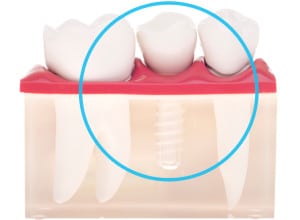Implant Dentistry
The practice of implant dentistry has arguably evolved more than any other facet of dentistry recently. The implant itself is basically a titanium screw-like structure that is placed into the bone during a minor surgical procedure. Titanium has the fascinating property of being biologically compatible with the body. Therefore, as the bone heals, the implant is incorporated seamlessly into the jaw. This is called osseointegration. When healing is complete an implant is an extremely solid structure that can be used to support crowns, bridges or dentures.
 After the implant has been in the bone for a period of time, typically 3 to 4 months, enough time has passed for osseointegration. Now the implant is strong enough to support a new tooth (or teeth). The next step is to attach a barrel-shaped structure called a mesostructure to the top of the implant. Next, an impression is taken and sent to a dental laboratory where a custom restoration is fabricated. At the final appointment, the new tooth or teeth are attached to the implant or its mesostructure with cement or screws. The final product is very strong, allowing the wearer to use the implant tooth with the same confidence as a normal, healthy tooth.
After the implant has been in the bone for a period of time, typically 3 to 4 months, enough time has passed for osseointegration. Now the implant is strong enough to support a new tooth (or teeth). The next step is to attach a barrel-shaped structure called a mesostructure to the top of the implant. Next, an impression is taken and sent to a dental laboratory where a custom restoration is fabricated. At the final appointment, the new tooth or teeth are attached to the implant or its mesostructure with cement or screws. The final product is very strong, allowing the wearer to use the implant tooth with the same confidence as a normal, healthy tooth.
New advances in implant technology are allowing dentists to immediately load the implant. This means that in some cases, it is possible to put the core and tooth on top of the implant immediately after the implant is placed. This is especially helpful for those who require implants in the front of their mouths. It avoids one having to wear a temporary denture for the period of osseointegration.
Another growing aspect of implant technology is the use of these structures to help conventional removable dentures fit more snugly. The attachments are called locators. In this case, instead of placing a core and false tooth over the implant, a small metal ball is attached onto the top of the implant. This is called the “male” attachment. Next, the “female” component is added to the denture such that the denture fits precisely onto the metal ball. The denture will now “snap” into place. People usually have at least two of these implant locators in order to retain the denture. The more implants used, the stronger the attachment. This procedure makes dentures fit very snugly and greatly improves a person’s ability to function with them. It eliminates the problem of dentures falling out when people eat, yawn or sneeze.

